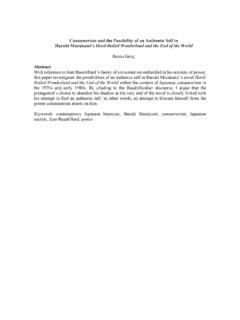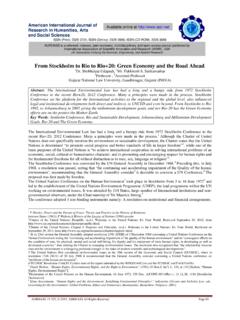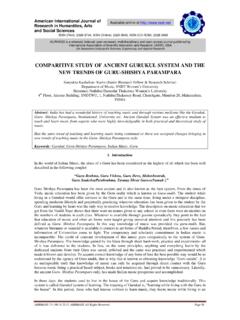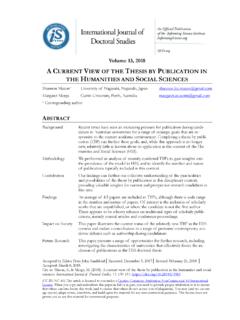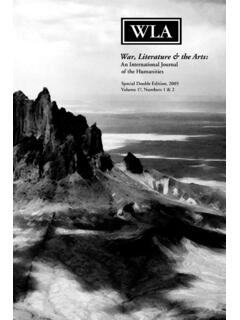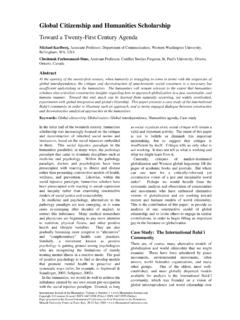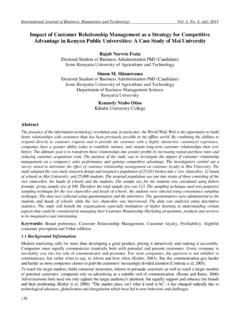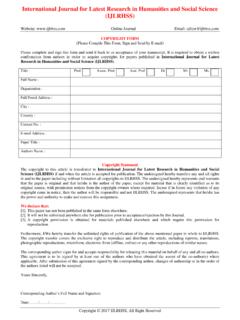Transcription of Photography and Visual Representations of the American War ...
1 Photography and Visual Representations of the American War in Viet Nam Er-Win Tan Senior Lecturer, Department of international and Strategic Studies University of Malaya Ted Engelmann Independent Scholar, Veteran of the American War in Viet Nam (1968-1969), and Freelance Embedded Photographer in Iraq (2008) and Afghanistan (2009) Abstract A picture says a thousand words , as the aphorism goes. This certainly applies to the realm of Photography . Yet, do photographs speak for themselves, or does the backdrop of photographs matter in underscoring the deeper underlying issues in wartime? As this manuscript shall examine, iconic photographs taken during conflict can have a deeply powerful symbolic impact in seizing the imagination and attention of the public.
2 In so doing, and depending on the context of the conflict being fought, such iconic imagery of war may impact not only on the decision-making process of that conflict, but also be adopted by other observers in the post-conflict to underscore underlying metaphorical themes in warfare. The authors propose to examine this in the form of five particularly iconic photographs from the Viet Nam War (known in Vietnam as The American War ). Keywords: war, Photography , iconic imagery, dissent, public opinion IAFOR journal of Arts & HumanitiesVolume 4 Special Issue Winter 201743 Introduction The weight of words, the shock of photos. (Advertising slogan for MATCH, Paris, 1949) A picture says a thousand words , as the aphorism goes.
3 This certainly applies to the realm of Photography . Yet, do photographs speak for themselves, or does the backdrop of photographs matter in underscoring the deeper underlying issues in wartime? With the international community set to face the continuation of war in the foreseeable future, it is necessary to ponder how wartime photographs reflect the deeper themes that frame the conduct of warfare in human history. The authors propose to examine how iconic photographs of the Viet Nam War (commonly referred to in Viet Nam as the American War ) capture the various controversies in that conflict. The authors propose to do this in the following four sections, beginning with a discussion of the characteristics of what makes an iconic photograph during wartime.
4 The second section of this manuscript examines the geopolitical backdrop of the American War in Viet Nam and why these factors render iconic photographs from this conflict a particularly interesting case study for Visual Representations of The authors will then proceed with a third section that delves deeper into five particularly iconic images from the American War, and how they represent that conflict. This manuscript will then conclude by considering the implications of Photography as Visual Representations of conflict in contemporary international relations. Photography as a Visual representation of war Although iconic images have been associated with various conflicts in human history since ancient times, it is only recently that any attempt has been made to undertake a particular in-depth analysis of the characteristics of particularly iconic images of warfare.
5 A recent contribution to this field comes in the form of War/ Photography : Images of Armed Conflict and its Aftermath, by Anne Wilkes Tucker, Will Michels and Natalie Zelt. Reviewing this manuscript in 2014, McMaster (then a IISS Consulting Senior Fellow who has since been appointed National Security Advisor in the Trump Administration) remarked that, Photography s ability to evoke the human and psychological experience of war gives the genre its unique value .. photographs contradict the notion that armed conflicts might be waged without profound human consequences, both for combatants and the civilians among whom wars are fought, as well as non-combatants who are often targeted deliberately by terrorist or military forces.
6 (McMaster, 2014, ) Further underscoring how particularly gripping photographs of conflict underscore the human tragedy of warfare was another article, published in 2014, in which Kenneth Jarecke reflected on a particularly gripping image of a corpse of an Iraqi soldier who had been burnt alive on the Highway of Death during the 1991 Gulf War. Time Magazine initially declined to 1 The authors refer to the American War in Viet Nam in recognition of the US-initiated political conflict through President Johnson s 7 August 1964 Gulf of Tonkin Resolution. In Vietnam, the conflict is referred to as The American War , holding responsible the invading country.
7 Furthermore, in seeking to emphasise that Viet Nam is a country and not a war, the authors spell the country as Viet Nam , without diacritical marks, throughout the article. See also Ted Engelmann, personal interview with photojournalist, Philip Jones Griffith, NYC, 8 September 2008. IAFOR journal of Arts & HumanitiesVolume 4 Special Issue Winter 201744 publish Jarecke s photograph, Incinerated Iraqi, Gulf War (26 February 1991), due to its graphic content. Photograph: Kenneth Jarecke, Burnt Iraqi Soldier , Highway of Death, Iraq, February 1991, As a result, the image in question did not reach public eyes until well after the conflict was over.
8 Yet, the impact of Jarecke s image in capturing the human cost of war must be emphasized; as Tony McGrath, the Observer s pictures editor noted, There were 1,400 [Iraqi soldiers] in that convoy, and every picture transmitted until [Jarecke s picture] came, two days after the event, was of debris, bits of equipment .. No human involvement in it at all; it could have been a scrapyard (McGrath, cited in Rose, 2014, ). Set against this backdrop, in capturing the last horrific moments of a man s life in conflict, Jarecke s image reflected the tone of General Sherman s observation that war is hell insofar as the human impact of warfare is concerned.
9 (Sherman, 1879) In this sense, Jarecke s iconic image strikingly underscored what warfare is all about: a period of mass-organized, politically-motivated violence during which people perish. Yet, it is not enough that an iconic photograph of war capture an image of sheer carnage; if anything, a photograph whose entire frame is filled with carnage is rather more likely to induce corpse-fatigue on the part of a viewer. Rather, it is more important for such iconic photographs to stand apart in a category by themselves in projecting into the popular consciousness a symbolic representation of the human impact of war.
10 Such an ability to capture the popular imagination is further reflected in how certain iconic portrayals of war have a pivotal impact on decision-making during the conflict itself, as well as how such iconic images are borrowed or referred to by later commentators. Backdrop of the American War in Viet Nam Several characteristics of the American War in Viet Nam make it an ideal case study for this manuscript. The most iconic photographs of US involvement during the Second World War were consistent with the then-prevailing historical narrative of American exceptionalism as part of the wider struggle against the militarism and ultra-nationalism represented by the Axis Powers.

